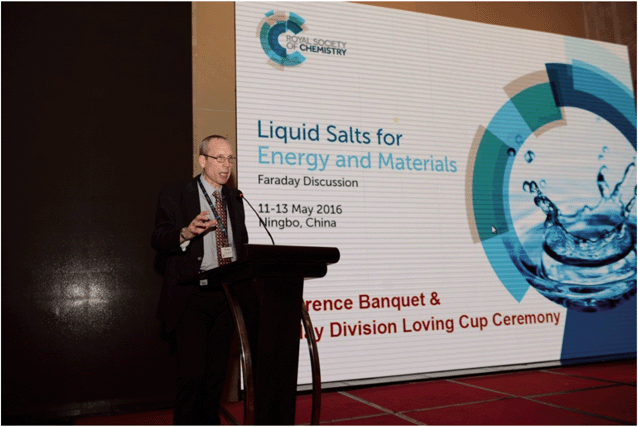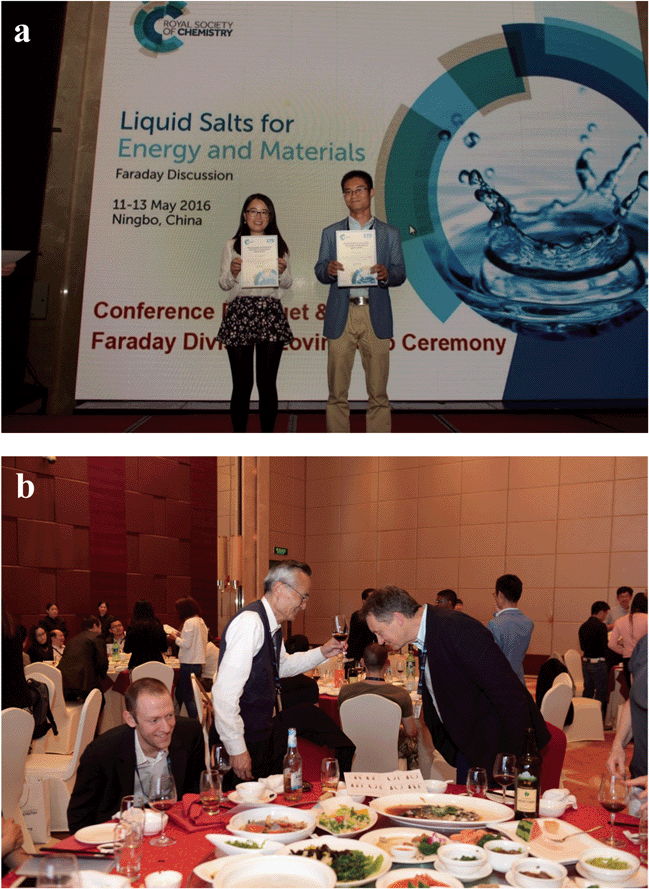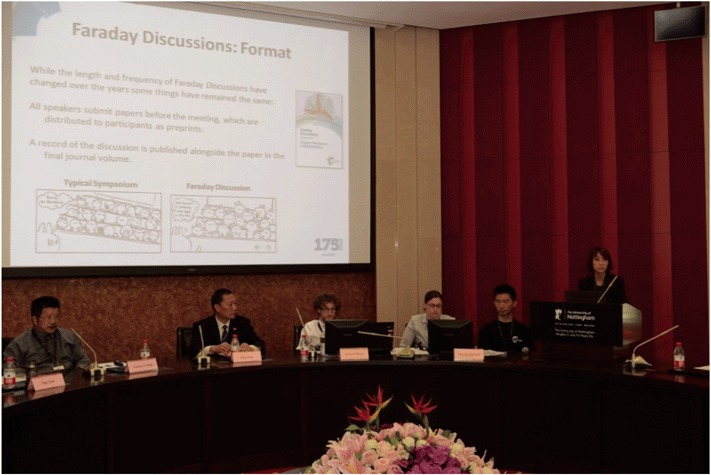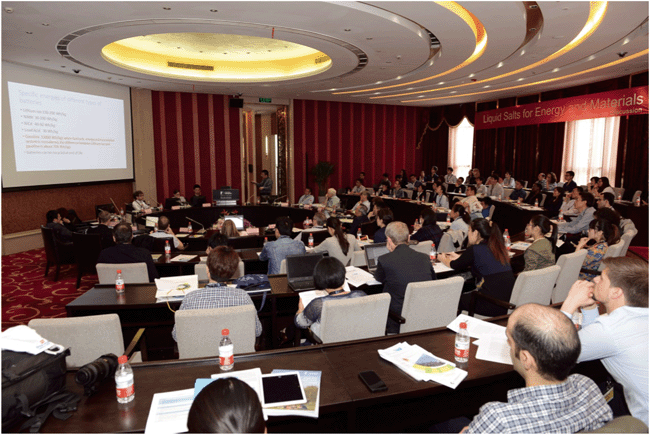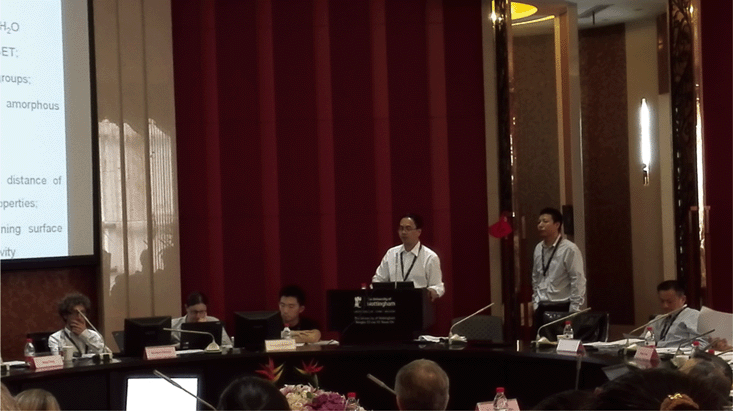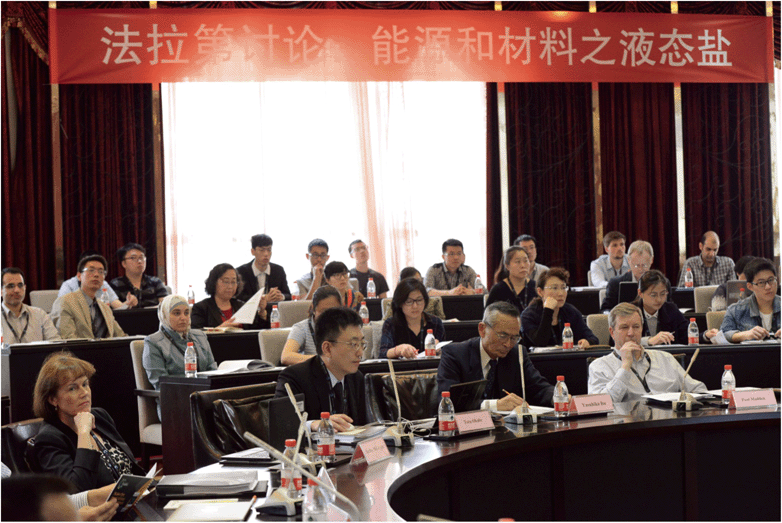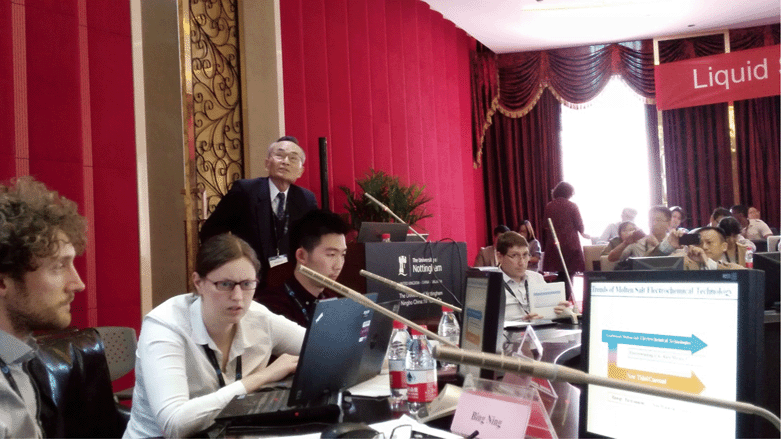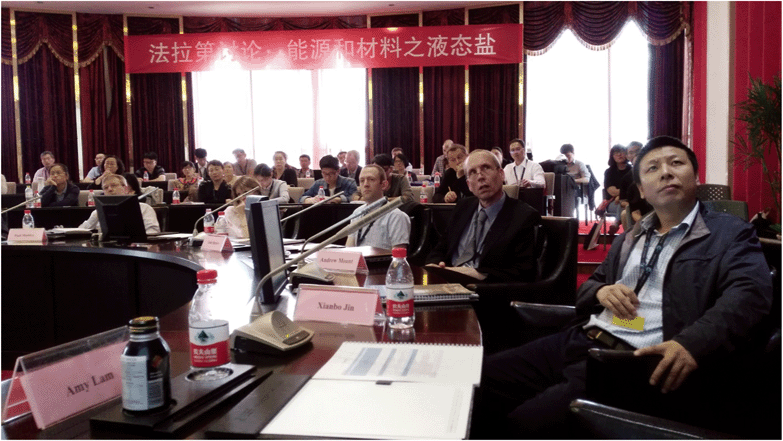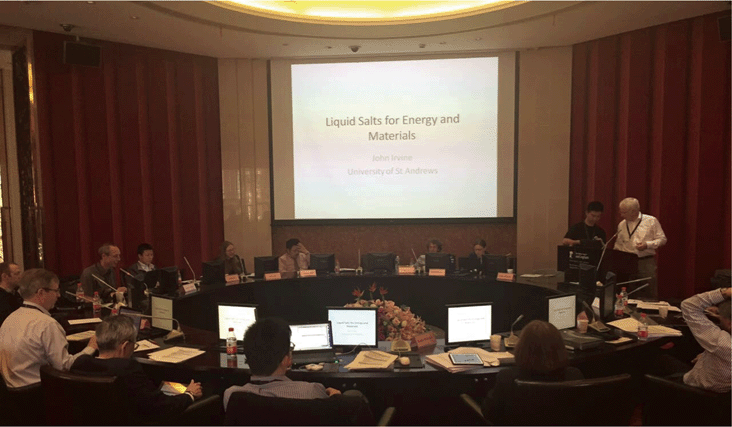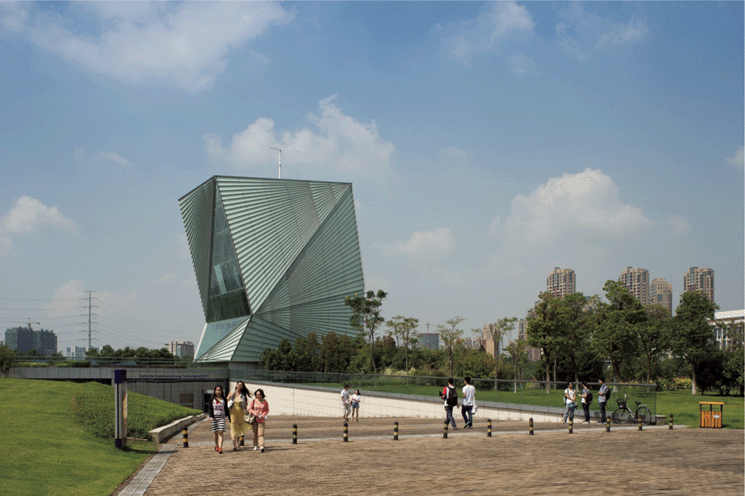Highlights from liquid salts for energy and materials – Faraday Discussion, Ningbo, China, 11–13 May 2016
Bamidele
Akinwolemiwa
a,
Linpo
Yu
a,
Di
Hu
a,
Xianbo
Jin
b,
John M.
Slattery
c and
George Z.
Chen
*ad
aDepartment of Chemical and Environmental Engineering, and Centre for Sustainable Energy Technologies, Faculty of Science and Engineering, University of Nottingham Ningbo China, Ningbo 315100, China
bCollege of Chemistry and Molecular Sciences, Hubei Key Laboratory of Electrochemical Power Sources, Wuhan University, Wuhan, 430072, P. R. China
cDepartment of Chemistry, University of York, Heslington, York YO10 5DD, UK
dDepartment of Chemical and Environmental Engineering, Faculty of Engineering, University of Nottingham, Nottingham NG7 2RD, UK. E-mail: george.chen@nottingham.ac.uk
First published on 7th October 2016
Introduction
In 1834, Michael Faraday reported his first discovery of the law of electrolysis, mostly through experiments in molten salts. Although it has a long history the subject of liquid salts has remained a growing field with diverse interests, including, but not limited to, oxide melts, ionic liquids, and deep eutectic solvents. In the context of the global challenges facing the present human civilisation, energy technologies and the supporting materials required to deliver these technologies are crucial, and liquid salts will play a key role here. However, they also find a great many opportunities for applications elsewhere, for example, in thermal, electrochemical, and nuclear energy applications. Even fossil-energy-related CO2 capture, conversion and utilisation can be accommodated efficiently in liquid-salt-based processes and devices. Thanks to their great range of working temperatures, liquid salts can offer significant benefits to improving reaction kinetics in the absence of precious metal catalysts, ionic conductivity to electrolysis current, and hence energy efficiency, and also to reducing environmental impact for many materials production and processing technologies without using volatile organic solvents. However, technological advancement relies heavily on a sound understanding of the underlying science. It is particularly important to understand the physical chemistry of liquid salts in order to deliver their potential in a range of applications. Given that there are a huge number of different liquid salts with quite different properties, the study of these materials leads to an exciting and diverse field. However, despite the differences between different areas of liquid salt chemistry there is still a link between all salts, as identified by Faraday himself long ago, in that the ions of opposite charges form a coulombic continuum. This link provides some common ground for all liquid salt researchers. With such a unique and historical link to Michael Faraday, the Royal Society of Chemistry approved the proposal from the Molten Salts Discussion Group (MSDG) to hold a conference on “Liquid Salts for Energy and Materials – Faraday Discussion”, aiming to offer a unique opportunity for all scientists and engineers to present, discuss and debate on past discoveries and future developments in relation to the understanding and application of liquid salts across a wide temperature range, from glowing red to cryogenic conditions, and a diverse range of applications.Over 100 participants (including PhD students, research fellows, leaders of research groups in academic institutions, industrialists, local officials and RSC administration staff) from the UK, Norway, Slovakia, Australia, Japan and China, gathered at Ningbo, a coastal city in China, to participate in the Liquid Salts for Energy and Materials – Faraday Discussion (see Fig. 1a for a snapshot of the registration process). This three-day proceeding commenced on 11th May 2016, and was hosted by the University of Nottingham Ningbo China (UNNC) with support from the Royal Society of Chemistry via the MSDG, and the Ningbo Association of Science and Technology.
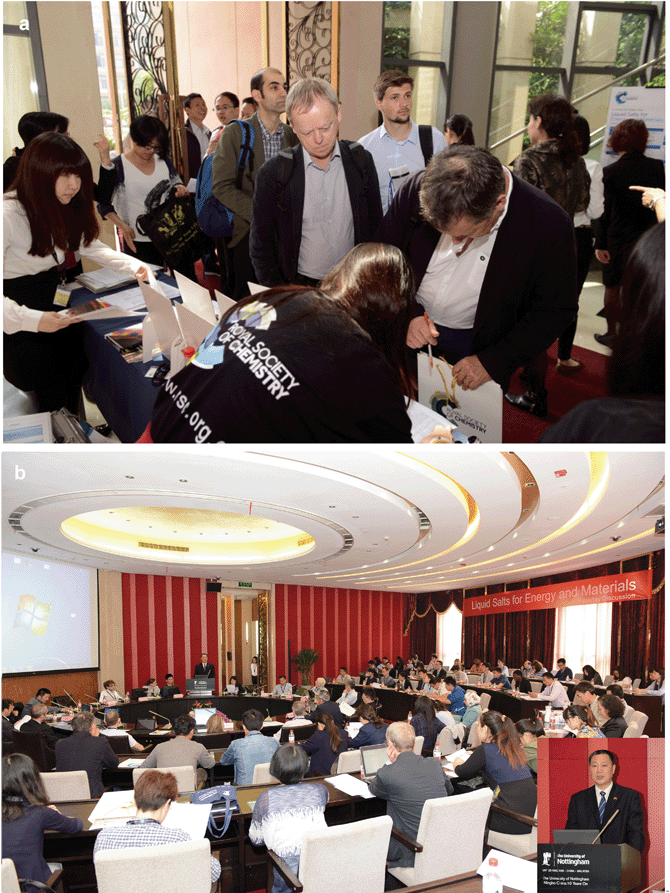 | ||
| Fig. 1 (a) Registration of delegates. (b) Mr Bin Ning (inset) of Ningbo Association of Science and Technology welcomes participants to Ningbo. | ||
The activities in this conference included vigorous scientific discourses and some engaging social interactions, which is characteristic of these Faraday Discussions, a series of highly recognised conferences in the chemical and physical science communities with over 100 years of history.1 The theme of this Faraday Discussion in Ningbo was centred on fundamental studies and the applications of liquid salts (LSs), which could be considered as a broad name for “ions or ionic matter” in the liquid phase at any temperature. As such, LS is a collective term for ionic liquid (IL) and molten salt (MS), which traditionally involve rather different temperature windows.2 A wide range of topics were covered during the meeting, with sessions divided into the broad themes of energy efficiency and environmental impact, energy conversion and storage, nuclear reactors and spent fuels processing, and fundamental studies of phenomena and processes in LSs. The detailed applications of LSs in the discussions included the production of materials (metals, carbon nanomaterials, silicon nanostructures, industrially relevant gasses such as Cl2, NH3, etc.), catalysis, novel electrochemical energy storage devices, and fission product processing, to mention a few. Reports and discussions involving fundamental studies showed the challenge and importance of utilising robust experimental designs in probing the properties of LSs, as well as the deep insights that computational techniques provide in the study of these materials.
There were also various interesting activities like the lightning presentation of research findings, the poster competition, and the conference dinner (see Fig. 2). At the dinner party, the best poster presenters and the conference volunteers (see Fig. 3a) were given awards, and the Loving Cup Ceremony (see Fig. 3b), a long-held Faraday Discussion Meeting tradition, was also held. All the delegates also got together for a group photograph (see Fig. 5).
This Faraday Discussion was formally opened with the welcome address by the Conference Chair, Prof. G. Z. Chen (University of Nottingham, UoN), and further opening addresses were given by Ms A. Lam (RSC China) (see Fig. 4) and Mr B. Ning (Ningbo Association of Science and Technology, see Fig. 1b).
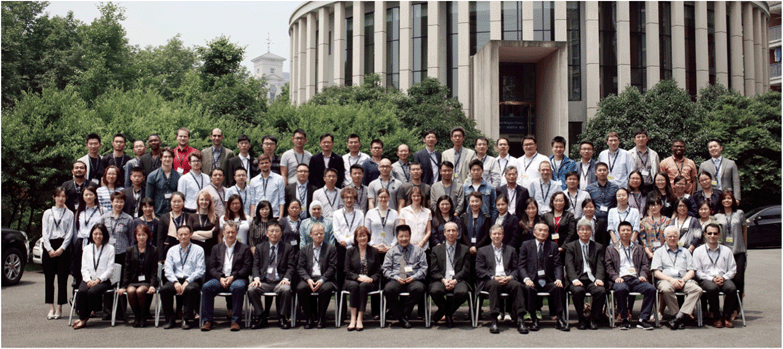 | ||
| Fig. 5 Group photo of the delegates taken in front of the International Conference Centre (ICC) at the UNNC. | ||
In accordance with the traditional format of all Faraday Discussions, each presenter gave a brief overview of their submitted paper in 5 min within their session, and then all attendees at the meeting were invited to take part in a discussion (questions, answers, and general comments) on all of the papers presented in the session. This discussion is an integral part of the Faraday Discussions and in effect allows for live peer review of the submitted papers.
There were around 20 minutes of discussion for each paper and all questions, comments and responses from the attendees and presenters were recorded by the RSC via the dedicated online portal. The record of these discussions has subsequently been published alongside the authors' papers in Faraday Discussions [DOI: 10.1039/C6FD90030E; 10.1039/C6FD90031C; 10.1039/C6FD90032A; 10.1039/C6FD90029A]. The following is an attempt to summarise the main highlights of this interesting scientific conference. Further detail can be found in the themed issue of Faraday Discussions dedicated to this meeting [Faraday Discuss., 2016, 190, 1–567].
Discussions
Introductory lecture
The discussions were opened by an introductory lecture given by Prof. G. Z. Chen (UoN) (see Fig. 6) on behalf of Prof. D. J. Fray (University of Cambridge, UK) who was unfortunately unable to attend the conference for medical reasons. The highly captivating lecture showcased the work of Prof. Fray's group in the electrochemical processing of materials, and also gave an important perspective and insight into energy sustainability in materials production using MS based electrochemical technologies. This lecture propounded Prof. Fray's view that Al extraction (mainly the Hall–Heroult process), Li production (electrolysis of molten LiCl), and extraction of Ti from its constituent minerals (via the Kroll and FFC Cambridge processes) are three main technological routes that would continue to define some key applications of MSs. The challenges of these technologies, and the vast opportunities for their innovation were also highlighted in the presentation. The production of graphene and other carbon nanomaterials, Si blackening for use in solar cells, production of Sn-filled carbon nanotubes and molten carbonate fuel cells, were all used as examples to display the broad applications of MS electrochemical technologies. At its heart, this lecture was an insight into the link between basic scientific research and commercial applications from the perspective of both academia and industry from an eminent scientist with decades of experience in electrochemical technology. The questions, answers and comments succeeding this lecture were a foretaste of the highly engaging discussions that characterised the three day proceedings. Regarding the work of Prof. Fray's group on the production of carbon nanomaterials from halide melts, the role of water vapour introduced to the LiCl melt, which under normal circumstances would corrode the high-temperature rig (as pointed out by Prof. G. Z. Chen) was explained by Dr A. R. Kamali (co-worker of Prof. Fray). Experiments show this vapour to be important, as it leads to H+ ions that are reduced on the cathode leading to the intercalation of H atoms in the graphite. The intercalated H atoms combine to form H2 with sufficient kinetic energy to exfoliate graphite into graphene. The details of this work were the subject of the talk presented two days later by Dr A. R. Kamali (DOI: 10.1039/c6fd00005c). The important question of the challenges of this process (particularly corrosion that could affect such a procedure in practice) was answered by pointing out that alumina and other cheap ceramics can mitigate corrosion in industrial applications. With respect to the perspectives of the FFC Cambridge process presented in the lecture, the question “what is the future of the FFC Cambridge process?” brought about an insight into the state of industrial application of the FFC Cambridge process. Notably, Prof. Chen pointed out that the successful route to commercialisation demonstrated by Metalysis (the UK based company with the rights to produce Ti using the FFC Cambridge process) was a far cry from what was obtainable in China. Essentially, Prof. Chen highlighted the communication gap between researchers across the continents as a major cause in this varying outlook on the potential of the FFC Cambridge process. Ultimately, Prof. Chen pointed out that the future of the FFC Cambridge process is bright, citing its application in the processing of spent nuclear fuel as an example of current resurgence in the utilisation of this process. Comments regarding the challenges of high temperature primary batteries, which were another topic of the lecture, showed that basic understanding of the fundamental electrochemistry in these processes is of immense importance. From a fundamental point of view, there were various comments on the importance of understanding metal dissolution in MSs, the role of optimal eutectic systems, and the effect of the cation and temperature on the electrochemistry of MSs. It was pointed out that the understanding of corrosion mechanisms in the FFC Cambridge process can help to shed light on dissolution mechanisms. It was also highlighted that the O2− diffusion mechanism is linked to the porosity of the cathode, just as the activity of this anion can be related to thermodynamics, electrode kinetics etc.Session 1: Benefit to energy efficiency and environmental impact
Prof. Chen chaired the first session of the discussions, and the presentation of papers kicked off with Dr K. McGregor's (CSIRO, Australia) report of their work on the development of an inert anode for titanium electrowinning (DOI: 10.1039/c5fd00235d). The talk discussed some of the challenges inherent in the development of anodes, and also explained that although these anodes are called “inert” they indeed display varying rates of reactivity in practice. It was shown that 6 mol% of Nb gives the optimum conductivity for their anode, and that replacing the Nb with, for example, Ta led to poor conductivity. Descriptions of the observed properties of the developed anode were given from the standpoint of the micro-structure of the anode, and the importance of material synthesis procedures (particularly sintering and post-processing) as principal factors that affected the performance of the produced anode was also explained. It was also pointed out that too much Nb would result in the formation of TiNb2O7 at the grain boundary of the developed anode material. Furthermore, it was shown that although the analysis of the 3-electrode IR drop measurements for this anode carried out using a bipolar pulse method revealed good performance throughout the test period, there was a noticeable change in the structure of the anode material. Towards the conclusion of the discussions for the presentation of these results, there was consensus amongst some delegates when it was suggested that chemical interactions at the anode-surface/electrolyte interface are one of the most important considerations for an inert anode. As to the discussions on the paper about the production of metal carbides via MS electrochemistry with the use of a solid oxide membrane (DOI: 10.1039/c5fd00221d) presented by X. Zou (Shanghai University, China), it was shown that the diffusivity of Ce is mainly responsible for its ability to stabilise Zr. The low current efficiency of the reported procedure as compared to what was obtainable in conventional solid oxide fuel cells (SOFCs) was suggested to possibly have a close link to the metal cations present in the process. Essentially, this process was able to show the feasibility of producing metal carbides via MS electrochemistry, although issues with controlling the side reactions of this process still pose some challenges.The theme of energy efficiency and environmental impact continued with the discussion of three more papers, and this session was chaired by Prof. Q. Xu (Shanghai University, China). The presentation given by the first speaker, Prof. G. M. Haarberg (Norwegian University of Science and Technology, Norway), focused on reducing the energy consumption and the emissions of CO2 and perfluorocarbons (PFC) in aluminium production by the introduction of natural gas anodes (DOI: 10.1039/c5fd00239g). Porous carbon anodes made from different graphite grades were investigated, and the isotropic graphite grade (G347) was found to be the best gas anode material. The best results from the investigations showed that methane oxidation reduced the carbon anode consumption by up to 56% of the theoretical carbon consumption during the 4 hour electrolysis in the molten fluorides. The next speaker in this session was Mr Y. Yuan, (Wuhan University, China), who presented the work done in Prof. X. Jin's group on the electrolysis of metal oxides in MgCl2 based MSs using an inert graphite anode (DOI: 10.1039/c5fd00231a). In this work, the electrolysis of Ta2O5 in a MgCl2–NaCl–KCl melt at 700 °C was investigated. A graphite rod was used as the inert anode, where the main anodic product was the Cl2 gas plus about 1 mol% O2 gas. The graphite anode was found to be very stable during the electrolysis because a very tiny amount of CO (0.2 mol%) and no CO2 was detected in the anodic gas production. The energy consumption for producing nanometre-sized Ta powder (50 nm) was about 1 kW h kg−1 with nearly 100% Ta recovery. The authors predicted that these MgCl2 based MSs could also be applicable for the preparation of many other metals and alloys with high energy efficiency and low carbon emissions. The third paper was presented by Mr Q. Shen (East China University, China). This report introduced a simple and inexpensive method for the direct preparation of AlFe alloy nanowires, which could be used as the negative electrode material in Li-ion batteries with outstanding cyclic performance, delivering a specific capacity of about 570 mA h g−1 after 50 cycles (DOI: 10.1039/c5fd00211g). The AlFe alloy nanowires were electrodeposited on Cu substrates in an IL, trimethylamine hydrochloride (TMHC)–AlCl3–FeCl3, and could accommodate the large volume change caused by the intercalation and deintercalation of Li+ ions.
Discussions on the aforementioned presentations commenced after Mr Shen's presentation. Relating to Prof. Haarberg's paper, most of the discussions were focused on the anodic reactions in the molten fluoride. When methane was supplied through the graphite anode, CO2 and H2O were produced during the electrolysis. It was believed that the H2O produced could not only react with fluorides to form HF (g), but could also affect the structure of graphite at the working temperature of 970 °C. The discussions on the second paper in this session involved the energy consumption and impacts to the environment of the process of producing Ta from the electrolysis of Ta2O5 in MgCl2 based MSs. It was confirmed that MgCl2 was transformed into MgO and most of this oxide stayed on the cathode (Ta2O5) pellet during the electrolysis. Essentially it was pointed out that the influence of MgO accumulation in the cathode was insignificant for the electro-reduction. It was also pointed out that O2− diffusion, which could lead to a limiting step in the efficiency of this process, can be controlled with good application/understanding of the PRS model, i.e., the theoretical model correlating the precursor porosity, P (in volume percentage), the metal-to-oxide molar volume ratio, R, and the cathode volume shrinkage S (in volume fraction, experimentally determined), which effectively describes the optimal properties of the cathode (in terms of pore size, metal to oxide ratio and shrinkage) that could lead to high efficiency metal extractions.3 On the anode side, the product was chlorine gas, which was considered to be a useful industrial product. It was pointed out that the environmental impact of the chlorine gas should not be a problem if the gas was fully collected and carefully transferred and stored for industrial purposes. Reports on the formation of AlFe alloy nanowires in the IL, which was the third paper presented in this session, were very attractive to the delegates, owing to the potential of these nanomaterials as promising negative electrode materials for Li-ion batteries. Although the capacity of the AlFe alloy nanowire electrode was relatively impressive, the potential range as displayed in the galvanostatic charge and discharge curves was still more positive than the commercial negative electrode materials for Li-ion batteries. The delegates also made comments on the correct usage of the terms “Anode”, “Cathode”, “Positive electrode” and “Negative electrode” as used in the electrochemical energy storage literature.
The theme of benefits to energy efficiency and environmental impact continued after a break with a session that was chaired by Prof. X. Jin (Wuhan University, China). The first speaker in this session was Prof. T. H. Okabe (University of Tokyo, Japan). His talk was titled “Direct oxygen removal technique for recycling titanium using molten MgCl2 salt” (DOI: 10.1039/c5fd00229j). He demonstrated that a Ti sample containing approximately 1000 ppm of O was deoxidised to less than 200 ppm by applying 3.1 V between the Ti and a C electrode for 86 ks in molten MgCl2 salt. It was predicted that this deoxidisation technique for the industrial recycling of metals might be of practical use in the future. The second speaker, Ms M. Eshtaya (University of Nottingham, UK), gave a presentation of their work on processing of lignin biomass in an IL, 1-ethyl-3-methylimidazolium ethyl sulphate ([C2mim][EtSO4]). The potential degradation of three types of lignin (lignosulphonate, Kraft and organosolv) was investigated in this IL containing a mediator, 2,2′-azino-bis(3-ethylbenzthiazoline-6-sulphonic acid) diammonium salt (ABTS). It was found that the solubility of lignin and viscosity of the solvent or solution played a vital role in the electrochemical oxidation reaction of lignin (DOI: 10.1039/c5fd00226e).
In the final talk of the session, Dr W. Xiao (Wuhan University, China) presented their recent work on MS treatment of waste biomass for preparation of carbon (DOI: 10.1039/c5fd00215) (see Fig. 7). The carbon material produced was shown to have applications as the electrode material in supercapacitors, and the carbon also exhibited enhanced electrocatalytic abilities for the oxygen reduction reaction (ORR). It was found that the MS, as a thermal medium, had a very important influence on the microstructure, surface chemistry, and electrochemistry of these carbon materials made from biomass.
The discussions commenced with the detailed responses Prof. Okabe gave to questions relating to the role of MgCl2 as the electrolyte in the extraction of titanium from metal scraps (titanium recycling) i.e. the de-oxidation of TiO2 and its alloys. The role of oxygen as an impurity or as a constituent of the electrorefined Ti was discussed in detail. It was also highlighted that whilst CaCl2 is the ultimate set-up for the electrorefining of Ti, MgCl2 lends itself to use when the metal-refining process is to be scaled up (due to its relative ease in handling). It was, however, pointed out that although MgCl2 is good for the purification of Ti, it is not the preferred choice for de-oxidation, because from a thermodynamic perspective, CaCl2 provides the best medium for de-oxidation of titanium. These detailed lines of discussion were in particular reference to a question about whether or not it would be possible to extract Ti from TiO2 in molten MgCl2 with the same process used in the extraction of Ta from Ta2O5 in the MgCl2 melt (i.e. the work presented by Prof. Jin's group). The low proportion of oxygen in the electro-refined Ti (less than 10 ppm) measured with the aid of the residual resistivity ratio method led to a number of comments on the varying proportions of oxygen observed in various methods of producing Ti electrochemically. There were also some insightful comments made on the electrodeposition of Ti. Regarding the paper on the processing of lignin in biomass, some questions on the oxidative products and electrolysis efficiency were raised. Moreover, it was explained that since the lignin was not directly oxidised on the electrode, it was really difficult to isolate the product from the electrolysis media and calculate the efficiency. It was confirmed that ABTS was a good charge carrier for the oxidation of lignin. The third paper which focused on the production of nanostructured carbon materials for supercapacitor electrodes by a MS electrochemical process resulted in some interesting discussions. For example, it was shown that whilst heating the carbon in the carbonate melt leads to the production of nanostructured carbon materials, merely heating the boiled coffee bean precursors to such high temperatures cannot produce the same effect. It was thus suggested that the MS acts as a template for engineering the nanostructure and effectively modifying the surface properties of the produced carbon. Furthermore, this work confirmed that the carbon made from impregnating boiled coffee beans in molten CaCl2 is characterised by a higher specific surface area and possesses more oxygen-containing surface functional groups and a less ordered microstructure than the one produced in molten Na2CO3–K2CO3: the ability of CaCl2-based melts to promote the hydrolysis of solutes was assumed to have played a role in the surface modification. Further discussions revealed that calculating the yield of the produced nanostructured carbon was challenging using the method adopted in the experiments, and there were also some difficulties involved in the cleaning of the produced carbon, although it was suggested that HCl cleaning was relatively successful.
After these highly engaging discussions, the lighting presentations were held in the same conference hall. All poster presenters had a chance to orally summarise their posters to the delegates in 30 seconds. The chair, Prof. Chen, timed each presentation in this special session. It was a real challenge for the speakers to present their research work in such a short time but many presenters successfully got their messages across and the presentations served as excellent adverts to entice the delegates to visit the posters. The poster session began immediately after the lightning presentations, and delegates had a chance to converse with the poster authors in the exhibition room (see Fig. 8).
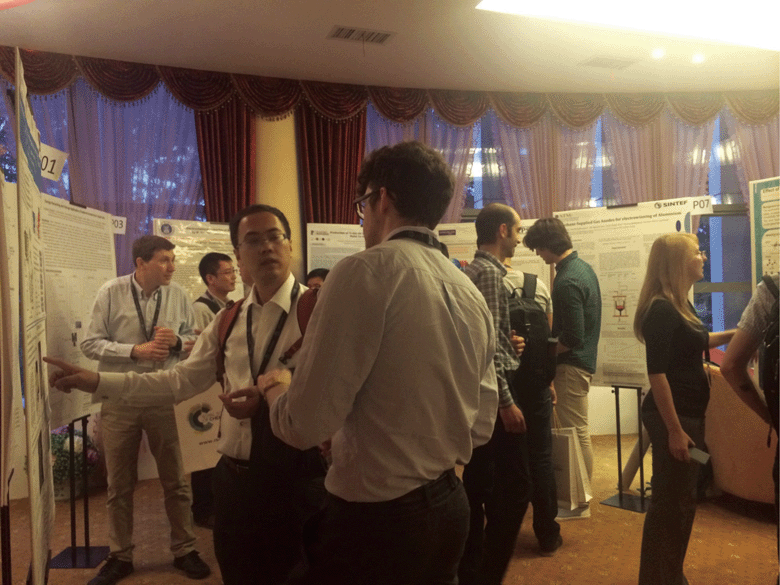 | ||
| Fig. 8 Posters presented by delegates (Photo Courtesy of Ms Mia Shen from University of Nottingham Ningbo Campus). | ||
Session 2: Improvement of energy conversion and storage
A new session focussed generally on the improvement of energy conversion and storage began on the second day of the proceedings (see Fig. 9), and was chaired by Dr J. M. Slattery (University of York, UK). The first talk gave an overview of a paper that focussed on the topic of thermal energy harvesting in ILs, which was presented by Dr J. Pringle (Deakin University, Australia). The presented paper focused on investigations of the Seebeck coefficients and thermoelectrochemical cell performance of a Co-based redox couple in a range of different ILs and their solutions with propylene carbonate (DOI: 10.1039/c5fd00238a). The second speaker, Prof. Y. Liu (East China Normal University, China), presented a paper titled “Immobilization of a rhodium catalyst using a diphosphine-functionalized ionic liquid in RTIL for the efficient and recyclable biphasic hydroformylation of 1-octene” (DOI: 10.1039/c5fd00195a). They found that using a diphosphine-functionalised IL allowed them to develop a highly efficient and stable homogeneous catalytic system, based on Rh, for the biphasic hydroformylation of 1-octene. One of their typical catalytic systems could run for 9 cycles without any loss of activity, which is good for a homogeneous catalyst system. The third speaker was Dr L. Yu (UNNC, China). He introduced their recent work on the so called supercapattery, a novel electrochemical energy storage device, using an IL electrolyte. The active material counted specific energy of the supercapattery based on a lithium negatrode (negative electrode) and an activated carbon positrode (positive electrode) could reach 230 W h kg−1 under a galvanostatic charge discharge current density of 1 mA cm−2. More details can be found from the paper titled “High energy supercapattery with an ILs solution of LiClO4” (DOI: 10.1039/c5fd00232j).The discussions on the three aforementioned papers began just after Dr Yu's talk. Owing to the interest shown by a lot of delegates in the various types of thermal harvesting devices, Prof. Pringle explained the principles of thermal energy harvesting devices based on semiconductors and redox couples in electrolytes. It was thus established that the mechanism of the redox-couple type thermal energy harvesting devices was based on entropy changes taking place during redox reactions of redox-active substrates in the ILs. Discussions on the second paper initially focused on the stability of the catalyst and the potential for the catalyst system to operate by directly using waste CO from other industrial processes, e.g. energy generation. The author's feeling was that unfortunately this suggestion was unlikely to be possible, as contaminants in such CO streams would likely poison the catalyst. There were then some discussions about the coordination chemistry of the ionic diphosphine ligand when bound to rhodium and the potential role of piperidine coordination to Rh in facilitating catalysis in the piperidine-functionalised ILs that were used in Prof Liu's work. When discussions turned to Dr Yu's work, some concerns were raised on the performance of the supercapattery and the safety issue of the LiClO4. It was, however, explained that the electrode materials and IL electrolyte were carefully selected in this work. During the discussion, there was a general agreement that the ionic-liquid-based organic electrolyte should be safe under the working conditions; moreover the solubility of the lithium salt in the solvent was highlighted to be an important point that needs further consideration. Essentially, it was explicitly shown that the supercapattery could perform better than the supercapacitor in terms of both energy capacity and self-discharge. Furthermore, the cost of the ILs was also discussed, and it was suggested that more testing with a range of ILs would likely identify cheaper ILs that still function well in this application, which would mean that these devices based on ILs could be deployed for commercial use in the future.
The second session of this aspect of the proceedings was chaired by Dr G. M. Haarberg, and the presentation was opened by Prof. D. Wang (Wuhan University, China) who presented his group's work on the capture and utilisation of CO2 by electro-transformation to capacitive carbon in MS (DOI: 10.1039/c5fd00234). This presentation highlighted the importance of the electrolyte composition in the absorption of CO2, and it was shown that different concentrations of metal oxides (Li2O or CaO) added to the LiCl–KCl eutectic led to increased absorption of the CO2. Also, it was explained that different eutectics (carbonate or chloride melts) lead to different reduction mechanisms. Furthermore, the authors pointed out that the electrolyte composition utilised in their experiments has a direct influence on the morphology of the produced carbon nano-materials; this was supported by showing that carbonate melts produced nano-particles whilst chloride melts produced nano-sheets. This was followed by the presentation of Mr J. Ge (University of Science and Technology Beijing, China) who described their group's work on the investigation of carbon nucleation and growth on a nickel substrate in LiCl–Li2CO3 melts (DOI: 10.1039/c5fd00217f). In this work they showed that only short-term electrolysis could lead to the formation of carbon nano-materials in the melt they employed. They also explained that the morphology of the carbon nano-material formed is strongly dependent on the type of substrate used, and their results showed that whilst any other cathode substrate e.g. Mo, resulted in the formation of sphero-carbon materials, only short-term electrolysis with Ni substrate can result in the formation of carbon-fibres. The presenter suggested that this might be linked to a possible catalytic effect of the Ni substrate. Following this presentation, Ms X. Yue (University of St. Andrews, UK) gave a talk on their group's work on the use of LSCM-GDC oxide anode for applications in direct carbon/coal fuel cells (DOI: 10.1039/c6fd00001k). Their work showed the use of carbon xerogels or bituminous coal as fuel sources for the Hybrid Direct Carbon/Coal Fuel Cell (HDCFC). It was pointed out that the introduction of carbonate to the anode was necessary to improve the interaction between the carbon and the SOFC anode, and the performance of the HDCFC making use of their infiltrated oxide anode showed comparative performance metrics to the Ni-YSZ cermet used traditionally. They also showed that the anode based on raw bituminous coal (which contains some ash content and sulphur impurities) gave similar performance to the anode based on the carbon xerogel. They linked this to the unique plastic transformation undergone by the raw bituminous coal during heating. Furthermore, they also reported that the LCM, on interaction with the carbonate at high temperatures, would change from the perovskite ABO3 structure to the A2BO4 structure, which was due to Li attack in a reducing atmosphere, conversely, the GCM retained a stable structure. Additionally, they also drew attention to their observation that the xerogel/carbonate residue from the cell reaction showed spontaneous ignition at room temperature when exposed to air. It was suggested that this may be due to the interaction of active phases of potassium from the carbonate, and that this observation may be linked to the potentiostatic current degradation observed when the xerogel was used as fuel in the HDCFC.
The discussion for this session commenced with questions on the shifting of the electrode potential of reduction of carbonate ion to more negative values observed in the work presented by Prof. Wang. The explanation given was that the shifting of the potential of carbon deposition was dependent on a number of factors but notably the composition of the electrolyte melt. It was also explained that the mechanism of reduction/re-oxidation is in general irreversible and quite complicated, as there could also be the formation of intermediate products in certain cases. Despite this, it was still pointed out that with the use of optimum eutectic melts, an appreciable amount of carbon deposition can still be achieved. Questions regarding the production of O2 at the anode were also asked, because it was pointed out that the rate of production of O2 at the anode would strongly correlate with the efficiency of electroreduction of CO2. In response to this, Prof. Wang drew attention to their attempts to measure the oxygen production at the anode, but also added that future work on this research would involve more detailed measurements of O2 production at inert anodes. Questions on the complexity of the reduction mechanism in various melt compositions (chlorides or carbonates) were answered by explaining that although the reaction is assumed to follow what can be obtained from basic thermodynamic data, the uncertainty in describing these mechanisms is strongly related to the difficulties in understanding the electrode kinetics. There were also detailed discussions about the role of the catalytic activity of the cathode since this is linked to the type of products that would be obtained at the cathode. The challenges in developing effective inert anodes for this process were also raised, and it was explained by Prof. Wang that SnO2 has been observed to be a relatively good anode in carbonate melts. He further stated that although there is still a lot of work to be done in the production of inert anodes for such processes, some promising anodes, for example, those based on alloys of Ni, are currently being developed. The discussions on the growth of carbon on nickel in the melt comprising LiCl–Li2CO3 revealed that it would be important to understand the diffusivity of carbon in Ni in order to further explain the catalytic activity, if any, of the Ni substrate. It was also highlighted that short-term electrolysis usually displays high current efficiencies at the cathode. An interesting insight was also raised by Prof. Chen on how high-resolution SEM/TEM images of the products from such processes could be used to probe the mechanism of such carbon production processes. Pointing to an SEM image presented by Mr Ge, Prof. Chen said that the obvious crystalline phase of the produced carbon formed on the substrate clearly demonstrates carbon formation via electrodeposition, as opposed to the chemical precipitation of carbon due to the reduction of the carbonate ion by Li, i.e. lithio-thermic reduction. The possible causes of the spontaneous ignition observed in the xerogel/carbonate residue reported in the presentation by Ms Yue were the subject of active discussions. Although the as-received carbon xerogel had a high oxygen content, after the pyrolytic reaction with K2CO3 (in which all volatiles were expectedly expelled), it became spontaneously combustible. It was suggested that perhaps this might be linked to the potassium ion in the carbonate potentially catalysing the oxidation reaction, or most likely due to the formation of a pyrophoric or highly reactive material during the process. The actual phase of the reactive potassium species that might be present (i.e. potassium metal or a peroxide) which facilitated this spontaneous combustion is still unclear. In general, the investigators pointed out that the observation of spontaneous combustion is not displayed by all carbon materials (the coal-carbonate residue did not show this property), but underlined this by saying that the surface area of the carbon could also play a role in this spontaneous combustion, because observations of some activated carbon displaying such properties after similar treatments have been previously reported.
Session 3: Developments for nuclear reactors and spent fuels processing
After the morning session and a break for lunch, Dr A. Doherty (Queens University Belfast, Northern Ireland) as session chair, opened the third session of the day, which focused on liquid salt applications in nuclear reactors and spent fuels processing. The first presenter for this session was Prof. Y. Ito (I'MSEP Co. Ltd, Japan) (see Fig. 10), who showcased a number of his company's R&D efforts at deploying novel MS electrochemical technologies (DOI: 10.1039/c5fd00237k). His presentation showed their work on the electrolytic synthesis of ammonia from water and nitrogen, which is based on a hydrogen permeable membrane in a dual electrolytic cell that operates at a much reduced cell voltage. Their work on the electrochemical production of carbon films and plasma induced discharge electrolysis to form nanoparticles was also generally outlined. J. Chen (Shanghai Institute of Applied Physics, China) presented their group's work on the investigation of the thermophysical properties of alkali carbonate eutectic MSs for heat transfer systems (DOI: 10.1039/c5fd00236b). In the presentation, the various experimental setups used to investigate the thermo-physical properties of a Li2CO3–Na2CO3–K2CO3 eutectic melt were outlined, and the various techniques used to ascertain the viscosity, thermal stability and heat capacity, thermal diffusivity, density and liquidus temperature were also described. Following this presentation, X. Liu (East China University, China) gave a presentation on their group's work on investigating the cathodic processes of neodymium(III) ions in LiF–NdF3–Nd2O3 eutectic melts (DOI: 10.1039/c6fd00014b). In their system they used the fluorides as supporting electrolytes and the oxides as the conductive components. Through studies by cyclic-voltammetry, they discussed the mechanism of reduction from Nd3+ to Nd2+ and the mechanism of reduction of Nd3+ to the metallic phase, with or without Nd added to the melt. As explained by the presenter, the results obtained from further electro-analysis i.e. square wave voltammetry and potentiostatic electrolysis, enabled them to confirm that the reaction is a disproportionation reaction, and that the cathodic reduction of neodymium(III) is fundamentally a two-step process. The discussions for this session commenced with questions on how the cell demonstrated by Prof. Ito could contend with the recombination of the nitride to form nitrogen gas. In response, it was pointed out that such reactions are dependent on the electrode materials used, and as such can be controlled by an adequate selection of electrode material. It was also highlighted that unwanted hydrogen evolution reactions are more prevalent at high current densities, and as such it is still a design challenge to reduce hydrogen evolution whilst operating the cell at a high current density. However, it was emphasized that the diffusion of hydrogen adatoms across the bipolar Pd membrane does not in itself result in the formation of hydrogen gas. There were also discussions on the role of optimal membranes in the electrolytic cell for the production of ammonia, and it was pointed out that membranes based on titanium–vanadium and other binaries/ternaries are currently under development. The role of the heating rate used for the DSC measurements utilized in the investigations carried out by J. Chen and his co-authors was the subject of much debate. For example, while some delegates suggested that a lower heating rate of 1 °C min−1 could be a better reflection of equilibrium conditions than the adopted 10 °C min−1 heating rate, especially when fundamental properties are to be investigated, other delegates raised opposing points which suggested that a 10 °C minute−1 heating rate is the most common heating rate adopted, and that it is only at such ramp rates that one could get observable peaks, such that average heating values can then be calculated on cooling. Although it was generally agreed that such high ramp rates are capable of shifting the values of the heat capacity measurements from equilibrium conditions, from practical considerations it was generally agreed that the ramp rate adopted by the investigators was acceptable. Insights were also made into the experimental procedures that were used in achieving homogeneous eutectics in order to prevent localised segregation in the mixtures used for the analysis of the thermo-physical properties conducted in the work. Regarding the work done on ascertaining the cathodic reactions of Nd3+ in LiF–NdF3–Nd2O3 melts, the issues of how to differentiate between the sweep-rate dependence of the peak currents corresponding to the various cathodic reactions of the neodymium ions were also raised. This is particularly important as this cathodic process is markedly close to possible cathodic reactions of lithium ions. It was also pointed out that the disproportionation reactions can be better studied in a chloride system. There were also practical inquiries on the methods of recovering electrode deposits from the melt.The session on developments for nuclear reactors and spent fuels processing continued with the presentation of three more papers. The first paper, which dealt with the fabrication of microelectrodes and its use in the electro-analysis of MSs, was presented by Prof. A. Mount (The University of Edinburgh, UK). In his talk, he gave reasons for the motivation to design microelectrodes for MS electro-analysis, such as the reduced IR drop, high signal to noise ratio, and reduced sensitivity to convection which such microelectrodes could achieve in electro-analysis. Results obtained from the use of the Molten-Salt Microelectrodes (MSMs) showcased the MSMs' ability to adequately probe mechanisms such as: the disproportionation reaction of EuCl3and the alloying of bismuth, which they studied by comparing the electro-analytical data of bismuth reduction with their micro-fabricated W and Pt MSM. Prof. Mount also explained that detailed analysis of the equivalent electric circuit (EEC) used to fit the EIS data obtained from their investigations possibly points to a fundamental difference in the mechanism of linear diffusional properties in molten (Li–K)Cl eutectic (LKE) and the ambient aqueous systems. After this, Dr I. Farnan (University of Cambridge, UK) presented his group's work on their 35Cl nuclear magnetic resonance study of LiCl–KCl based MSs in conjunction with the effects of dissolution of CeCl3 in such melts (DOI: 10.1039/c6fd00003g). In this presentation, the difficulty of the 35Cl nucleus for NMR investigations was highlighted; moreover, it was shown that the group's modification of a probe and experimental set-up used for earlier studies were employed for the in situ element-specific investigations undertaken in the current study. It was also emphasized that the small separation between the LiCl and KCl chemical shifts (about 8 ppm), also posed challenges in the investigation of the LiCl–KCl eutectic, although in contrast this was pointed out to be somewhat of an advantage because when additives (fission products for example) are added to such eutectics any observed change could be easily identified as being due to the effect of the additives. Dr Farnan described how relaxation-time measurements of the eutectic after the addition of fission products (Ce used as a surrogate in the data presented) could be used to understand the mechanisms controlling viscosity and diffusivity of various elements in such eutectics. It was explained that the use of sophisticated molecular dynamic calculations, coupled with ab initio NMR calculations, would be employed to fully understand some of the findings from this investigation. Following this presentation, L. Yuan (Institute of High Energy Physics, Chinese Academy of Sciences, China), presented some results from the work of Prof. W. Shi's group on the investigations of intermetallic compounds in the LiCl–KCl eutectic studied with the aid of cyclic voltammetry (DOI: 10.1039/c5fd00220f). In this presentation, it was highlighted that understanding the formation of intermetallic compounds is useful in the bid to develop optimal means of separating actinides from lanthanides in fission products. It was shown that by re-plotting their cyclic voltammetry data as current vs. time, peak current areas could be used to ascertain the coulomb numbers, which in turn were used to estimate the composition of the intermetallic compounds. Brief, but comprehensive, descriptions were given of some examples of the indexation of some cathodic peaks corresponding to metallic deposition and the formation of intermetallic compounds, and anodic peaks corresponding to decomposition of the intermetallic compounds (by the dissolution of metallic ions into the melt) or re-oxidation of deposited metals. It was also pointed out that the electro-analytically derived composition of the intermetallic compounds formed agreed with XRD measurements. The discussions for this session were opened with questions relating to the considerations made when using the CPE and Warburg elements to model the data obtained from impedance measurements on the macro- and micro-disk electrodes in the molten and ambient aqueous LKE electrolytes described by Prof. Mount. Comprehensive explanations given by Prof. Mount to this line of inquiry confirmed that the global-fit model adopted for the analysis of the data is the optimal means of achieving realistic understanding of the process. There were further detailed comments on the role of the physico-chemical properties of the melt (temperature, viscosity, etc.) on the possible upper limits for the dimensions of these MSMs, and general sensitivity of their performance. Regarding the study of the 35Cl NMR, responses to some questions showed that the chemical shift data relates to the structure. There were some interesting comments made by Prof. Madden (University of Oxford, UK) on how the relaxation times can be linked to the mechanism of field gradient formation. Furthermore, discussions on the time-scale of the measurements were used to compare the NMR technique to Raman spectroscopy. Throughout these discussions, the need for additional theoretical simulations to further understand the results from these NMR measurements was highlighted. The discussion on the cyclic voltammetry of intermetallic compound formation in eutectics was mainly centred on the analysis of the positions of the cathodic peaks (metallic deposition or intermetallic formation), and anodic peaks (metal dissolution) as it relates to the possible mechanisms of the formation and disintegration of various phases of the reported intermetallic compounds i.e. Ce–Al, Er–Al, and La–Bi.
Session 4: Advancement in knowledge of phenomena and processes
The first session of the third (and final) day of the proceedings was chaired by W. Xiao (Wuhan University, China), and the first paper was presented by Prof. H. Zhu (University of Science and Technology Beijing, China). This presentation described their work on establishing some fundamental equilibrium thermodynamic properties of the Ti ions and Ti metal in fused alkali chloride melts (DOI: 10.1039/c6fd00007j). It was shown that the generally accepted disproportionation reactions of titanium ions were carefully equilibrated with titanium metal whilst fluorine was added to the melt to change the equilibrium conditions. When this paper was discussed by the delegates, further details regarding the disproportionation reactions were explained. For example, it was explained that forming a strong complex is not necessarily good for these investigations, whilst it was also disclosed that although Ti2+ is good for production of titanium metal in practice, the stability of Ti4+ is more useful if the metal is to be achieved directly. Furthermore, questions were asked about the method for calculating the stoichiometry of the equilibrium reactions, and it was explained that the complexes proposed in the reaction mechanism were based on assumptions about the valence and structure, and also that equilibrium conditions were assumed to be constant with the number of fluoride ions coordinated to Ti assumed to be from 1 to 6. Essentially, statistical and chemical stoichiometry was used to calculate the ΔG values obtained in this work. There were also some concerns raised about the accuracy of using the data for Ti2+ and Ti3+ in water as an actual analogue for what is obtainable in the melt; nevertheless most delegates agreed with the explanation that such procedures are standard stoichiometric methods of indirectly ascertaining equilibrium conditions. The second paper in this session was presented by Prof. J. Yang (General Research Institute for Nonferrous Metals, China), on the application of the FFC Cambridge process in the reduction of SiO2 to Si nanowires (NWs). It was shown that the process conditions led to the formation of straight silicon NWs. Through the general discussions for this paper, it was pointed out that the 3-Phase Interlines (3PIs) are important in the production of the NWs, and that the size of the Ni nanopowder affects the production of the nanowires. Furthermore, an interesting highlight was that, using either Ni or NiO as the catalytic additive shows no difference in the product quality of the nanowire produced. However, it was also pointed out that safety issues in the preparation of Ni powder preclude its use as a direct catalyst in this process. Dr A. R. Kamali (University of Cambridge, UK) presented their paper on the large-scale production of graphene powders in MSs and their application in the production of ceramics (DOI: 10.1039/c6fd00005c). This led to a series of engaging discussions on some fundamental properties of carbon production by electrochemical methods in MSs. It was pointed out that highly crystalline graphite is a better precursor for the production of graphene in this system, and that the rate of production of graphene is strongly related to the rate of intercalation of H+. Moreover, a main point of discussion on this paper was the role of the H+ and Li+ cations in the production of graphene. Although from the presentation it was explained that H+ intercalation is necessary for the production of graphene, there was a counter point raised in the discussion which also claimed that the intercalation of Li+ can also play a role in the production of graphene. This point, raised by Prof. Chen, cited earlier work that predated the formal report of the discovery of graphene; it was explained that in this investigation carbon nanotubes were produced from melts of (Li–Na–K)Cl eutectic. TEM and SEM images of the formed products in addition to carbon nanotubes, revealed other forms of carbon, some of which showed similar structures to what are now recognized as graphene.4 Although a general consensus was not reached on a proper way of describing the mechanism of exfoliation observed in this carbon production process, the discussions resulting from this talk led to insights into the practical large-scale high-temperature production of carbon nano-materials in general.The second session on Friday morning continued the theme of the advancement in knowledge of phenomena and processes, and was chaired by Prof. Y. Liu. The first speaker in this session was Prof. P. A. Madden (University of Oxford, UK). He presented their simulation work on the coordination numbers and physical properties of MSs and their mixtures (DOI: 10.1039/c5fd00223k). He and his co-authors found significant differences in structure and dynamics between MSs containing small and larger cations. These were sufficient to explain the different behaviour of the viscosities of the MSs. They also drew attention to the similarities and differences of the metal cation networks that formed in highly viscous, glass-forming materials like BeF2:LiF. Their work emphasised an important point that there is simply no such thing as a “co-ordination number” for the metals in melts containing the trivalent metals that were studied. Instead, it is rather more accurate to visualise the system as containing a distribution of valence numbers, with the shape of this distribution dependent on the composition of the melt. The second speaker, Dr B. Hu (UNNC), presented the paper titled “Effect of C8minPF6 on miniemulsion polymerization for application in new latex coating products” (DOI: 10.1039/c6fd00009f). This use of ILs in latex coating materials was a generally new research area to some delegates. Dr Hu introduced the low VOC latex coatings which were achieved by encapsulating the IL C8minPF6 inside particles via miniemulsion polymerisation. The final speaker of the conference should have been Ms D. H. A. T. Gunasekera (University of Nottingham, UK), who unfortunately was not able to attend the conference. As such, her colleague Ms M. Eshtaya (University of Nottingham, UK) gave the presentation in her place. In the reported experiments, ILs were used as the solvent to dissolve cellulose. This IL/cellulose mixture was then used to print 3D patterns using ink-jet printing. Regeneration of cellulose from the printed samples was also demonstrated. The details of this work can be found from the published paper titled “Three dimensional ink-jets printing of biomaterials using ILs and co-solvents” (DOI: 10.1039/c5fd00219b).
The discussions of the papers in this session began just after the final presentation (see Fig. 11). Some delegates were intrigued by the predictions of viscosities of MSs presented by Prof. Madden. Most of the discussions were focused on the relationship between the viscosity of the MSs and the network structures of the metal cations and anions. The discussions on Dr Hu's paper were mainly on the ILs aspect. It was believed that the ILs containing the surfactant group in the structure can perform better than the mixture of the ILs and surfactant. Since the author of the third paper was absent, Ms Eshtaya tried her best to answer all the questions from the other delegates. The viscosity of the printing solution was of concern to some of the delegates. It was pointed out that the 3D printing machine had some limitation on the viscosity of the printing solution. In this case, the authors have carefully chosen the solvent of the solution. As to some detailed questions, the chair reminded that the delegates could leave their questions to the forum, which would be answered by the authors of the paper. At last, a general discussion was held in this session. And these discussions were mainly centred on how the properties of the IL are used to assess its application, the broad relationships between MSs and ILs were also discussed.
Concluding remarks
After the discussions for the final session of the proceedings, the session chair for the Concluding Remarks, Prof. G. Z. Chen invited general perspectives on the relationship between the two main classes of LSs i.e. MSs and ILs. Regarding the fundamental differences between MSs and ILs from the perspective of theoretical simulations, Prof. Madden suggested that the two classes are basically the same when viewed from a general macroscopic thermodynamic standpoint, he however stressed that some marked differences between these two classes of LSs begin to unravel when microscopic considerations are fundamentally investigated.Through detailed descriptions of the fundamental structure of liquid state ions, he exemplified the observed higher local hetero-phase formation that ILs display compared to MSs as one fundamental microscopic difference between these two classes of LSs. Furthermore, reasons for the challenges in obtaining robust theoretically calculated thermodynamic data for ILs similar to those currently in use for most MS systems was explained from the standpoint that the vast array of ILs display varying inter-molecular and intra-molecular interactions coupled with additional rotational degrees of freedom, essentially making these simulations very complicated. An additional example to show some observations in the differences between ILs and MSs raised by Prof. G. Z. Chen, and corroborated by Dr J. Slattery, is that whilst mixing two or more salts for MS investigations is a well-known experimental practice that reduces the viscosity of the melt (and also the melting temperature in particular), recent work has shown that mixing two ILs does not necessarily reduce the viscosity of the mixture. In fact, on mixing, viscosity is increased in some cases, which is likely due to changes in nano/microstructure that are dependent on the IL composition. These concluding discussions, which aptly attempted to put the general properties of the two main classes of LSs in perspective, gave a sense to all delegates that whilst continued studies on these individual classes of LSs are leading to ground-breaking findings in their own right, there is obviously a great need to undertake more fundamental and unifying studies that seek to understand these systems as ions in liquid phases. The concluding remarks on the entire proceeding were presented by Prof. J. T. S. Irvine (University of St. Andrews, UK) (see Fig. 12). This engaging presentation which outlined a brief over-view on all the papers presented was able to concisely recap the interest that the different papers generated.
Engagement with local communities
This Faraday Discussion also saw delegates engaging with local communities for science and technology exchange. During the scheduled breaks in the conference proceedings, delegates visited UNNC laboratories in the Faculty of Science and Engineering, and also the Centre for Sustainable Energy Technologies (CSET) which has been built with the concept of zero-carbon emission, utilising various forms of renewable energy and storage technologies to support all activities in the building. It is itself a large piece of research equipment for studying various building-environment interactions, and also accommodates research facilities in energy materials and other related technologies (see Fig. 13). After the completion of the conference programme, all delegates were invited to visit a local energy company, Ningbo CRRC (China Railway Rolling Stock Corporation). At the Ningbo CRRC delegates were led on a guided tour of the production facilities of the supercapacitor factory which manufactures high energy and high power supercapacitors using activated carbon electrodes and organic electrolytes. The delegates also had an inner-city ride on a city bus (see Fig. 14) that is fully powered by supercapacitors. This reminder of the potential impact that scientific research could have in creating a sustainable human civilization was indeed a fitting end to a profoundly interesting and inspiring Faraday Discussion.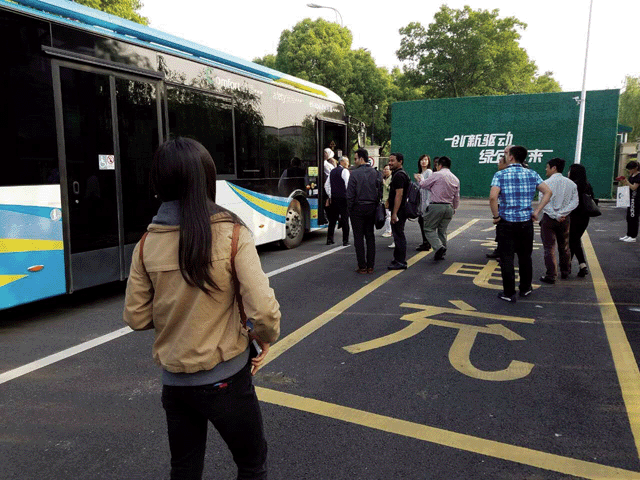 | ||
| Fig. 14 An inner-city ride on a bus which uses the supercapacitor as the power source. (Photograph courtesy of Prof. Yun Gao from North China University of Science and Technology.) | ||
References
- http://www.rsc.org/about-us/our-history/our-origins/ .
- http://www.nottingham.ac.uk/Engineering/Departments/Chemenv/People/george.chen .
- H. Chen, Y. Zeng, W. Li, J. Peng, X. Jin and G. Z. Chen, Electrochem. Commun., 2013, 26, 33–36 CrossRef CAS.
- G. Z. Chen, I. Kinloch, M. S. P. Shaffer, D. J. Fray and A. H. Windle, High. Temp. Mater. Proc., 1998, 2, 459–469 CrossRef CAS.
| This journal is © The Royal Society of Chemistry 2016 |

